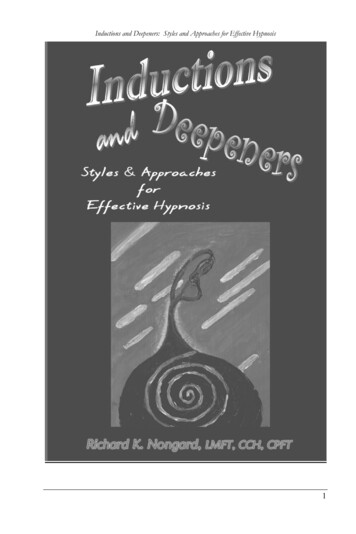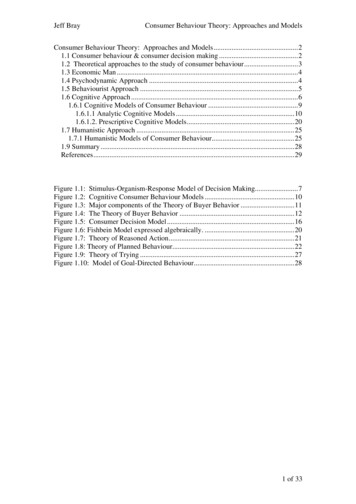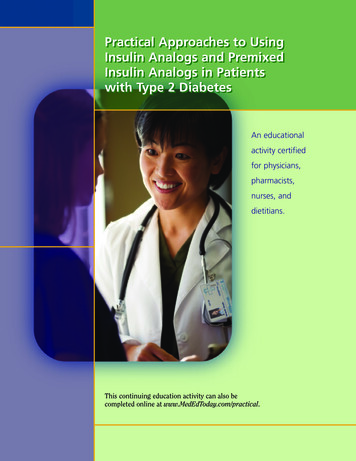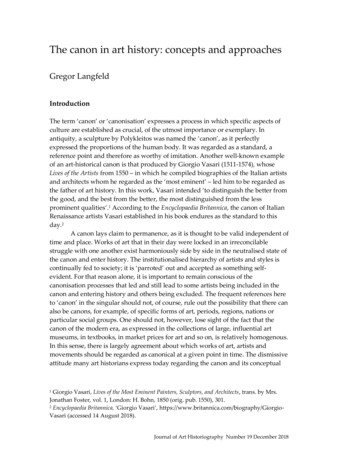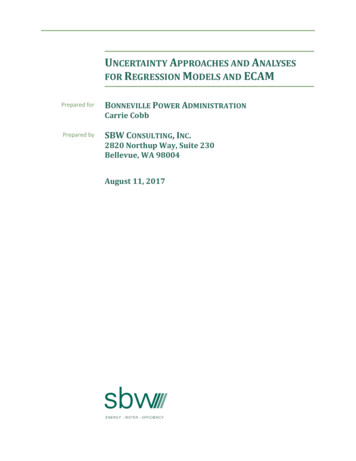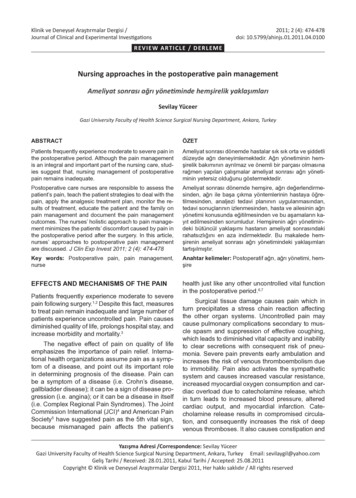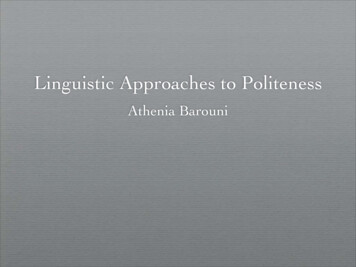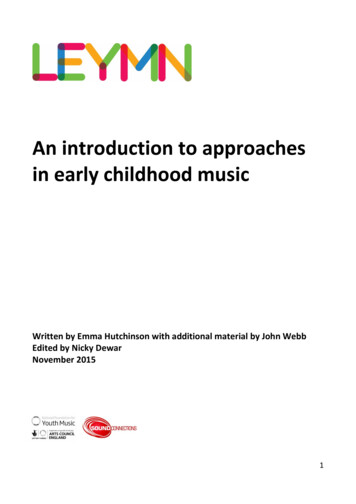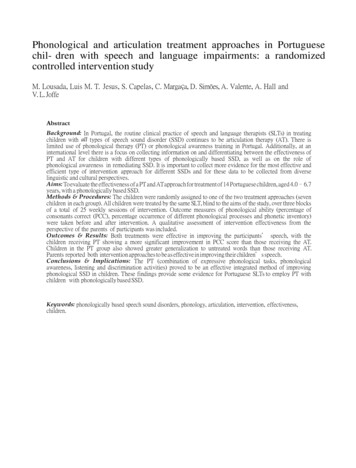
Transcription
Phonological and articulation treatment approaches in Portuguesechil- dren with speech and language impairments: a randomizedcontrolled intervention studyM. Lousada, Luis M. T. Jesus, S. Capelas, C. Margaça, D. Simões, A. Valente, A. Hall andV. L. JoffeAbstractBackground: In Portugal, the routine clinical practice of speech and language therapists (SLTs) in treatingchildren with all types of speech sound disorder (SSD) continues to be articulation therapy (AT). There islimited use of phonological therapy (PT) or phonological awareness training in Portugal. Additionally, at aninternational level there is a focus on collecting information on and differentiating between the effectiveness ofPT and AT for children with different types of phonologically based SSD, as well as on the role ofphonological awareness in remediating SSD. It is important to collect more evidence for the most effective andefficient type of intervention approach for different SSDs and for these data to be collected from diverselinguistic and cultural perspectives.Aims: To evaluate the effectiveness of a PT and AT approach for treatment of 14 Portuguese children, aged 4.0–6.7years, with a phonologically based SSD.Methods & Procedures: The children were randomly assigned to one of the two treatment approaches (sevenchildren in each group). All children were treated by the same SLT, blind to the aims of the study, over three blocksof a total of 25 weekly sessions of intervention. Outcome measures of phonological ability (percentage ofconsonants correct (PCC), percentage occurrence of different phonological processes and phonetic inventory)were taken before and after intervention. A qualitative assessment of intervention effectiveness from theperspective of the parents of participants was included.Outcomes & Results: Both treatments were effective in improving the participants’ speech, with thechildren receiving PT showing a more significant improvement in PCC score than those receiving the AT.Children in the PT group also showed greater generalization to untreated words than those receiving AT.Parents reported both intervention approaches to be as effective in improving their children’s speech.Conclusions & Implications: The PT (combination of expressive phonological tasks, phonologicalawareness, listening and discrimination activities) proved to be an effective integrated method of improvingphonological SSD in children. These findings provide some evidence for Portuguese SLTs to employ PT withchildren with phonologically based SSD.Keywords: phonologically based speech sound disorders, phonology, articulation, intervention, effectiveness,children.
What this paper addsWhat is already known on the subject?Phonological therapy (PT) and traditional articulation therapy (AT) have been shown to be effective in remediatingphonologically based speech sound disorder (SSD) in children speaking English.What this paper addsPT and AT were found to be effective in improving phonologically based SSD in children speaking EuropeanPortuguese as their main language, with the phonological approach being the more effective of the two. Sincetraditional AT is the most typical form of intervention in Portugal for children with all SSDs, these results havethe potential to provide SLTs in Portugal with empirical evidence regarding the relative benefit of PT versus AT forchildren with SSD.IntroductionChildren with phonologically based speech sound disorder (SSD) are reported to present with difficulties intheir phonology, which can be observed by the numberof phonological processes evident in their speech (Beers1992, Roberts et al. 1998, Bortolini and Leonard 2000,Orsolini et al. 2001, Mediavilla et al. 2002, Bree 2007).The majority of these phonological processes signal a delay in development, because they occur in the early stagesof normally developing children. Unusual patterns nottypically seen in normal development have also been reported (Beers 1992, Mediavilla et al. 2002, Bree 2007).A phonologically based SSD has also been associatedwith poor phonological awareness and with later literacyproblems (Catts 1991, Bird et al. 1995, Stothard et al.1998, Gillon 2000a, Snowling et al. 2000, Catts et al.2002, Rvachew et al. 2003, Botting et al. 2006). Thus,it is crucial that speech and language therapists (SLTs)work on expressive phonological skills and phonological awareness in order to support the underlying skillsfor literacy in children with phonologically based SSD(Gillon 2000b, 2004).Intervention approaches for speech sound disorder(SSD)For many years the most typical treatment approach forchildren with SSD was the traditional articulation approach (Van Riper 1939). In this approach the overallgoal is for children to learn how to articulate individualphonemes to improve the intelligibility of their speech(Baker 2006). Ingram’s (1976) work changed the focus of the problem from an articulation disorder (focuson individual sounds) to a phonological disorder (focus on patterns of speech sounds). Consequently, thischange in focus transformed the assessment and management of SSD. Assessment now routinely includes aphonologically based analysis by identifying patterns ofdifficulty (e.g. /g/ produced as [d] and /k/ produced as[t] indicating the same error pattern, i.e. fronting), andphonological process analysis (Baker 2006). The focus ofintervention is typically no longer on individual speechsound production, usually targeting one sound at a time,but rather it focuses on the elimination of error patterns and the change of the child’s phonological systemthrough a process of phonological generalization. Forthis reason, as part of phonological therapy (PT), SLTswork with groups of sounds in words, as children withphonologically based SSD are seen to have a linguisticproblem with the organization and use of phonemes tosignal meaning rather than a more motoric or structuraldifficulty which an articulation disorder might suggest(Baker 2006). There is also a range of procedural differences which differentiate articulation therapy (AT) fromPT, including differences in use of strategies, therapy activities, treatment words and feedback (Bernthal et al.2008).However, in Portugal, where this study was conducted, observational reports suggest that the routineclinical practice to date of SLTs in treating children withall SSDs continues to be AT. There is limited awareness or use of PT or phonological awareness training inPortugal and speech and language therapy students inPortugal are trained during their clinical placements touse the traditional articulation approach for all childrenwith SSD. At an international level, information on theeffectiveness of PT and AT for children with phonologically based SSD, and the role of phonological awareness in remediating SSD, is growing. It is important toknow more about what type of intervention approachis effective for which disorder, and to build as strong anevidence base as possible for a chosen intervention (Joffe2008, Baker and McLeod 2011).There are different therapies in use for children withphonologically based SSD (Joffe and Pring 2008, Bakerand McLeod 2011), e.g. auditory discrimination (Berryand Eisenson 1956), minimal opposition contrast therapy (Weiner 1981), AT (Van Riper and Emerick 1984),cycles approach (Hodson and Paden 1991), Metaphon(Howell and Dean 1991), and phonological awareness(Gillon 2000b).There is an ongoing need to assess and compare theeffectiveness and efficiency of interventions that SLTs
report to use in their current practice, e.g. articulationversus PT (Joffe and Pring 2003, 2008).Auditory discrimination, minimal contrast therapyand phonological awareness were identified as the mostpopular intervention approaches used by SLTs in clinicalpractice for children with SSD in a survey in the UK,with more than 50% of respondents always or oftenusing them on their own or in combination (Joffe andPring 2003, 2008). The ‘popularity’ of minimal contrasttherapy has been reported more recently in a narrativereview of intervention studies published from 1979 to2009 for children with SSD (Baker and McLeod 2011).Out of a total of 134 intervention studies included inthe review, 46 distinct intervention approaches for SSDwere identified, with 23 of them described in more thanone publication. Of these 23 intervention approaches,minimal pair intervention was the most commonly citedtreatment approach and was associated with 42 of thestudies reported (Baker and McLeod 2011). The effectiveness of each of these approaches needs to be investigated to ensure that clinical practice mirrors researchfindings.Gillon (2000a, 2000b) demonstrated that children,aged between 5.6 and 7.6 years with a phonologicallybased SSD benefitted from phonological awareness intervention. The phonological awareness interventionin Gillon’s studies focused on developing phonological awareness at the phoneme level. The aim was tofacilitate change in phonological skills by targeting thechild’s awareness of the contrastive nature of soundswhilst also working on production of sound patterns.The intervention proved to be an effective method ofresolving the children’s speech production errors andalso improved phonological awareness and reading ability (Gillon 2000b). In this study, a comparison wasmade between phonological intervention in combination with phonological awareness versus a more ‘traditional articulation’ approach. Children who were treatedwith a phonological awareness intervention (which included a focus on increasing phonological awarenessand grapheme–phoneme correspondence knowledge, aswell as providing appropriate opportunities for speechproduction), showed greater improvement than children treated with a ‘traditional articulation intervention’ that focused predominantly on resolving speechsound errors without any phonological awareness work(Gillon 2000b). In contrast, Hesketh et al. (2000), ina study that also compared AT with metaphonologicaltherapy (focusing on both general phonological awareness activities and on more specific awareness activities involving their target phonemes/processes), but withyounger children (between 3.6 and 5.0 years), concludedthat the two therapy groups made the same amount ofprogress in speech production as measured by the percentage of consonants correct (PCC) score, with thechildren from the AT group making more progress onone measure of speech improvement—a naming task.Unlike Gillon (2000b), they found no advantage forthe group receiving metaphonological therapy. Thereare some key methodological differences in these twostudies which may account for some of the variationsin outcomes. First, the participants in Gillon’s (2000b)study were older than those in Hesketh et al.’s (2000)study and may therefore have had more exposure tothe alphabet and been better equipped to utilize the information provided in the phonological awareness intervention, which incorporated grapheme–phoneme correspondence knowledge. Second, Gillon’s (2000b) phonological awareness approach included opportunities forspeech production, in conjunction with the phonological awareness work. In contrast, Hesketh et al. (2000)included production only in the final 2 weeks of the intervention programme, and during this period childrenwere not explicitly corrected on their speech attemptsper se, but rather were given more general feedback onthe phonological features of their utterances. And third,Gillon’s (2000b) articulation approach was a ‘phonemeorientated approach’, targeting individual phonemes using Van Riper’s (1939) traditional articulation approach.Hesketh et al.’s (2000) ‘articulation therapy’, in contrast,targeted either phonemes or classes of phonemes andprocesses and therefore appeared to be more phonologically based.There are other studies comparing articulation versus phonological intervention that found PT to be moreeffective than traditional AT (Klein 1996, Pamplonaet al. 1999). Klein (1996) compared the efficacy andefficiency of PT with traditional AT in the treatment ofchildren (between 3.0 and 5.10 years) with SSD. Children in the PT group showed significantly more improvement and in a shorter period of time than childrenin the traditional therapy group. Pamplona et al. (1999)also compared PT with AT in a randomized controltrial with children with cleft palate, between the agesof 3.1 and 7.1 years, with compensatory articulationdisorder (CAD). The focus of this study was on overallefficiency, i.e. the total time of speech therapy (takenfrom onset of speech therapy to complete normalizationof the disorder) required for correcting the CAD. Themean total time of speech intervention required to remediate the CAD in the phonological treatment groupwas less than half the amount of time (14.50 months)than that required for the articulation treatment group(30.07 months). These results show that the overallspeech therapy time was significantly reduced when using a phonological treatment approach compared withan articulatory method, and provides evidence to suggestthat PT is more efficient than traditional AT.Teutsch and Fox (2004) reported four case studies(aged between 3.10 and 4.2 years) with a consistent
phonological disorder. Two children were treated withPT and the other two with a traditional articulation approach. The results suggested that PT promoted betterprogress in children’s phonological abilities (measuredin PCC and percentage of phonological processes) thanthe AT.Considering the evidence, it is apparent that bothapproaches can be effective in improving speech forchildren with SSD. Most of the studies, however, haveshown PT to be more effective than AT. Despite thisfinding traditional AT is the approach most typicallyused in Portugal to treat children with all SSDs (including articulation disorders, consistent and inconsistentphonological disorders) and it is this use of AT acrossall clinical cases in Portugal that motivated the development
Phonological therapy (PT) and traditional articulation therapy (AT) have been shown to be effective in remediating phonologically based speech sound disorder (SSD) in children speaking English. What this paper adds PT and AT were found to be effective in improving phonologically based SSD in children speaking European Portuguese as their main language, with the phonological approach being the .
